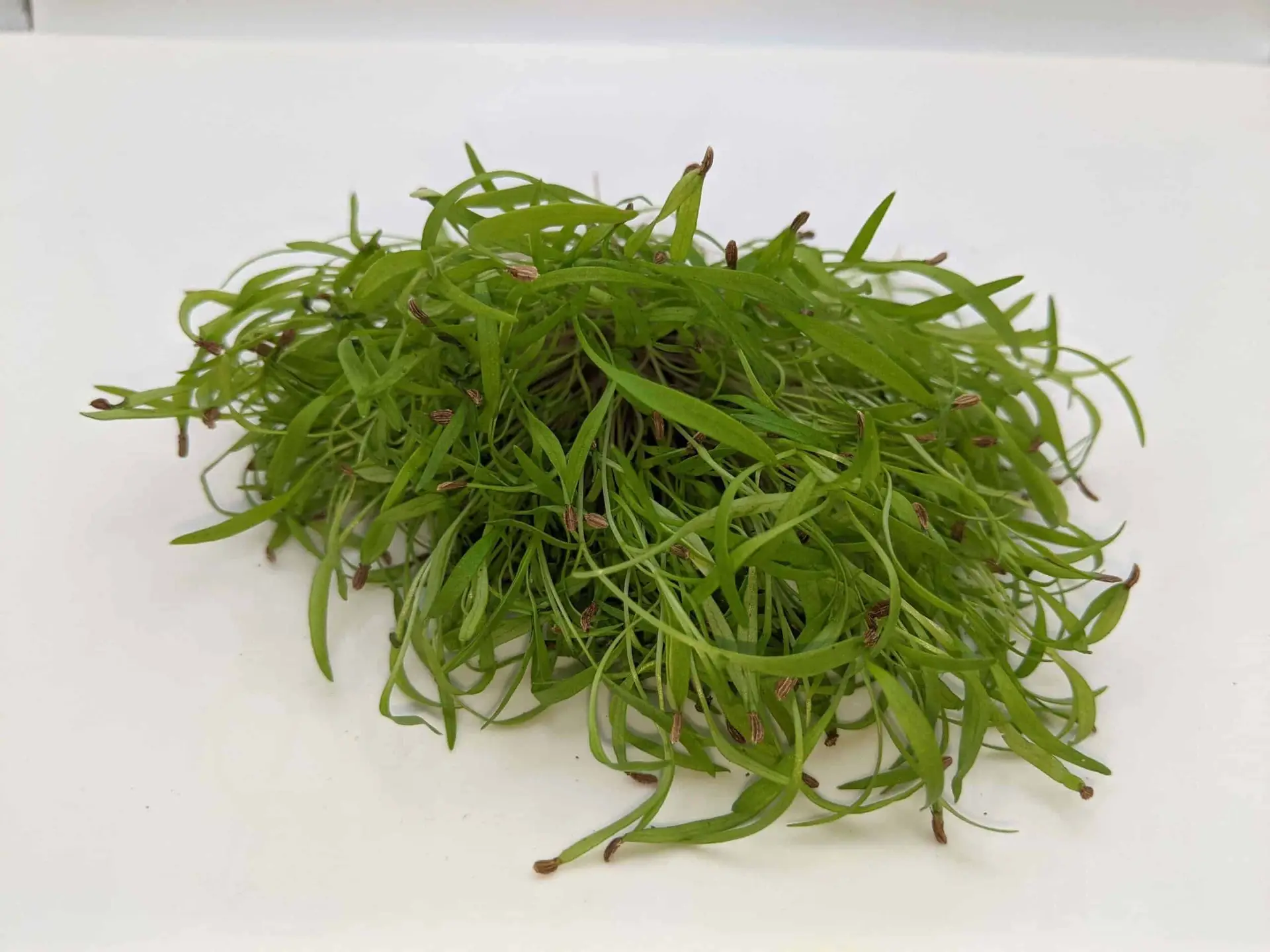Carrot Microgreen Nutrition Fact Sheet

The properties of carrot microgreens have made this food a "superfood" or a "functional food." This means that its value is not simply in its nutritional contribution but is also considered a food with health-promoting and disease-preventing properties.
Most microgreens are characterized by a very high concentration of antioxidants. However, carrot microgreens stand out for their contribution of beta-carotene above all others.
Although they are a microgreen type that takes longer to harvest, they are worth waiting for their nutritional value and sweet taste.
Carrot microgreens are ideal for omelets, smoothies, and even sweet preparations. They differ from the rest of the microgreens because of the mild and sweet flavor contribution that allows them to be used in various dishes such as sandwiches, salads, soups, smoothies, and cakes like carrot cake.
Nutrition Profile
In addition to their culinary properties, carrot microgreens provide different benefits thanks to their nutritional contribution. These seedlings are an excellent source of beta-carotene, potassium, and soluble fiber. That is why they help to:
Maintain a healthy immune system: beta-carotenes are precursors of vitamin A, an essential nutrient for the immune system. Vitamin A helps keep the body's mucous membranes and cellular barriers healthy, so it acts as a first line of defense against pathogens that can cause disease.
Prevent chronic diseases: Beta-carotene has antioxidant properties, which means it can help protect the body's cells from damage caused by free radicals. Free radicals are unstable molecules that can damage cells and contribute to chronic diseases such as heart disease, cancer, and autoimmune diseases.
Maintain eye health: The body converts some beta-carotene into vitamin A, accumulating in the eye's retina, and helps maintain vision and eye health.
In addition, beta-carotene has antioxidant properties, which means it can help protect the eyes from free radicals that can cause cell damage and contribute to eye diseases such as age-related macular degeneration and night blindness.
Improve skin and mucosal health: Vitamin A, which is produced by the body from beta-carotene, is an essential nutrient for maintaining healthy skin. Vitamin A helps replenish and regenerate skin cells, which helps keep skin soft, smooth, and wrinkle-free. It also helps control sebum production, the oil produced in the skin's sebaceous glands, which can help treat acne.
Prevent digestive diseases: Carrot microgreens' soluble fiber helps maintain healthy intestinal flora. This type of fiber ferments in the intestine and serves as a source of energy for colonocytes.
Maintain stable blood glucose levels: The soluble fiber in carrot microgreens also helps avoid blood glucose spikes, as it slows digestion and helps sugar from meals to be absorbed slowly. This is ideal for people with diabetes or any other carbohydrate metabolism disorder.
Maintain proper weight: Carrot microgreens are very low in calories, so they help to increase the volume of meals, providing satiety without increasing caloric density.
Carrot microgreens also provide vitamins B, C, D, E, calcium, and iron in smaller quantities.
In conclusion, carrot microgreens are an ideal option to add to the diet in various health and disease situations.
References
Baswan, S. M., Klosner, A. E., Weir, C., Salter-Venzon, D., Gellenbeck, K. W., Leverett, J., & Krutmann, J. (2021). Role of ingestible carotenoids in skin protection: A review of clinical evidence. Photodermatology, Photoimmunology & Photomedicine, 37(6), 490–504. https://doi.org/10.1111/phpp.12690
Blomhoff, R. (2005). Dietary antioxidants and cardiovascular disease. Current Opinion in Lipidology, 16(1), 47–54. https://doi.org/10.1097/00041433-200502000-00009
Evans, J. R., & Lawrenson, J. G. (2017). Antioxidant vitamin and mineral supplements for preventing age-related macular degeneration. Cochrane Database of Systematic Reviews, 7(7), CD000253. https://doi.org/10.1002/14651858.CD000253.pub4
Johra, F. T., Bepari, A. K., Bristy, A. T., & Reza, H. M. (2020). A mechanistic review of β-carotene, lutein, and zeaxanthin in eye health and disease. Antioxidants (Basel, Switzerland), 9(11), 1046. https://doi.org/10.3390/antiox9111046
McRorie, J. W., Jr, & McKeown, N. M. (2017). Understanding the physics of functional fibers in the gastrointestinal tract: An evidence-based approach to resolving enduring misconceptions about insoluble and soluble fiber. Journal of the Academy of Nutrition and Dietetics, 117(2), 251–264. https://doi.org/10.1016/j.jand.2016.09.021
Mora, J. R., Iwata, M., & von Andrian, U. H. (2008). Vitamin effects on the immune system: vitamins A and D take centre stage. Nature Reviews. Immunology, 8(9), 685–698. https://doi.org/10.1038/nri2378
Wehner, S. (2007). 24 carrots have been served to our veterans. Journal of the American Dietetic Association, 107(8), A109. https://doi.org/10.1016/j.jada.2007.05.415
(N.d.). Isu.edu. Retrieved April 28, 2023, from https://www.isu.edu/media/libraries/rural-health/microgreens/Microgreen-Nutritional-Profile.pdf
Disclaimer: The information provided in this article is for educational and informational purposes only and is not intended as medical advice. It is not a substitute for professional medical advice, diagnosis, or treatment. Always seek the advice of a qualified healthcare provider with any questions you may have regarding a medical condition. The author and publisher of this article are not responsible for any adverse effects or consequences resulting from the use of any suggestions, preparations, or procedures described in this article.

